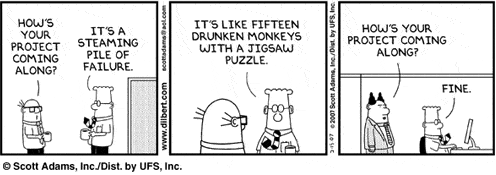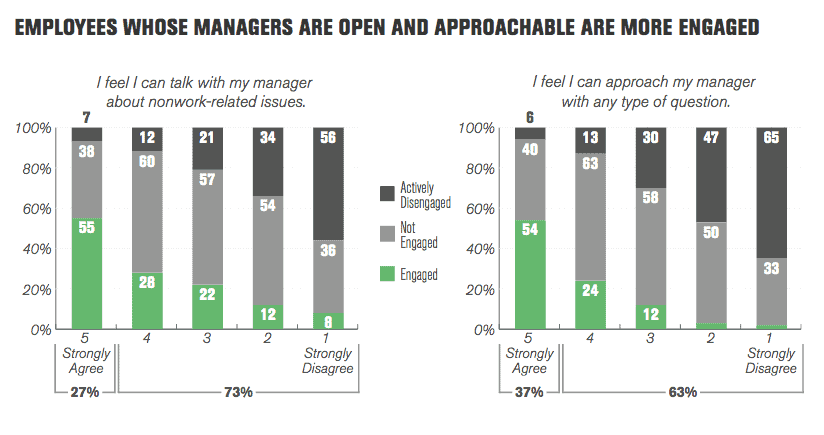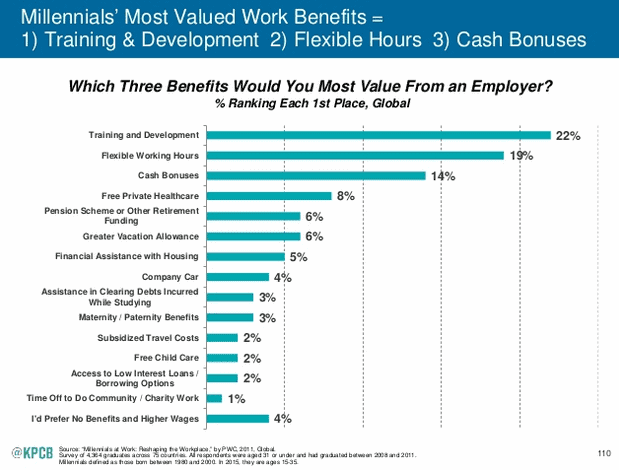Do you want to be average or GREAT? Are you the kind of person that was proud of skating by with a C, or were you willing to make the often small efforts that would turn that into a B or an A?
More importantly, is getting mediocre work from your team enough? Can you skate by just getting passing grades for you and from your team? Is that why you were given the promotion to manager? Doubtful.
Bring out you and their best.
In today's high pressure, high tech environment, where one motivated person can make tremendous contributions to a team and a company, you can least afford to settle for "good enough."
Leaders set the example for their teams and the performance that they expect. When you mail it in, they will too. When you do just good enough work, so will they. The 10/10/10 rule for one on ones, is mediocre at best, and a massive missed opportunity at worst.
One on ones are the single best investment you can make as a manager in your team. Done right, the return on your investment is enormous. If you want to have a high performing, engaged team that is fun to work with, and can help you advance your career (and theirs), then you want to abandon the 10/10/10 rule. Here's why:
Why the 10/10/10 Rule is for Mediocre Managers
If you're having one on ones with your team, regardless of structure, it's a good start. However, there's so much more you can do that the 10/10/10 rule limits you from accomplishing.
When Andy Grove, former CEO of Intel wrote, "Ninety minutes of your time can enhance the quality of your subordinate's work for two weeks, or for some eighty-plus hours” he was talking about when you have great, not average one on ones.
What is the 10/10/10 Rule?
Before we break down what's wrong with the 10/10/10 rule, let's quickly review how it works. It's pretty simple:
10/10/10 is 10 mins for Them, 10 mins for You, and 10 mins to talk about the future.
It's short. It's catchy. It's easy to remember and follow each time you have a one on one. Unfortunately, it also misses out on a lot.
1) 10 minutes isn't enough for them.
Have you ever had a big, thorny problem in your life you needed help with? Could you solve it in 10 minutes? Probably not.
These problems occur in both your personal and professional life, and unfortunately, they always take more than 10 minutes to resolve. When you only give them 10 minutes, you force them to only bring up trivial issues that can be solved in that time.
But don't take my word for it. Andy Grove wrote his management tome, High Output Management:
"The subordinate must feel that there is enough time to broach and get into thorny issues.
Look at it this way. If you had a big problem that you wanted to kick around with your supervisor - the person whose professional interest in the matter is second only to yours - would you want to bring it up in a meeting scheduled to last only fifteen minutes? You would not."
You cannot afford to miss these big problems. The harsh truth is that they are exactly the issues that cause frustration, disengagement, and looking for other jobs.
There is no other time to talk about them other than a one on one. This means you either make time for them now or they never happen. And ten minutes isn't enough to get into them.
2) The structure encourages status updates.
As we've spoken with hundreds of managers for Lighthouse, a common pattern we've found is that managers using the 10/10/10 rule, also tend to fall into a pattern of asking questions like:
- What did you work on last week?
- What are you working on this week?
- What are your blockers?
With only 10 minutes, it's easy to spend all your time on this and never get into bigger, important questions. Who can't come up with 10 minutes of filler project conversation? Many companies waste hour-long meetings on such topics.
Status updates are a terrible waste of your one on ones. Once you try having a one on one that gets beyond them, I guarantee you'll never go back. The other topics you can cover have such a higher value, you'd never want to let such a low-value discussion back in.
3) 30 minutes may not be enough time for the whole meeting.
The other big problem with the 10/10/10 rule is the total length. 10 + 10 + 10 = 30.
Unfortunately, 30 minute meetings are often anything but that.
You may start 5 minutes late because of something beforehand running long. Even if you do start on time, you'll be getting a buzz on your phone for a meeting reminder for the next meeting 5 minutes before, too. Chances are, from that moment on, your mind is on getting to the next meeting.
When you combine those two, you only realistically have 20 focused minutes to talk. That means you'll never get into any type of rhythm or depth of discussion.
Often, the most critical discussion topics come up around minute 25 of a one on one. If you only have 30 minutes set aside, you run into the problem of that being right when you are supposed to be wrapping things up. Andy Grove describes this problem as "zingers":
"The supervisor should be wary of the "zinger," which is a heart-to-heart issue brought up at an awkward time...the subordinate might tell you something like he's unhappy and has been looking outside for a job and give you only five minutes to deal with it."
The timing is the root of the mediocrity of this approach. You never get into what really matters to them. They're dis-incentivized to bring anything big up and you can easily fall back on generic questions for your 10 minutes.
--
We're all about actionable advice here at Lighthouse and we know you can only do what you may have learned before. So we want to teach you the right way to have a great one on one. With these tips you can start having better one on ones today.
How to have one on ones like a pro and ditch the 10/10/10 rule
With just a few tweaks to what you're already doing, we can make your one on ones go from 0 to 100.
1) Set aside an hour.
By booking an hour on your calendars, you avoid having to run right when a "zinger" comes up at minute 25. It also means if you start a little late, you still have plenty of time to talk.
When you have an hour, it's also safe to end early. It's easier to end at 45 minutes, when you set aside an hour, than it is to run 15 minutes over in a 30 minute meeting.
If you can't make time for everyone for an hour every week, an hour every 2 weeks is better than 30 minutes every week; much of the value of a great one on one is in going deep on critical subjects, which means you need to have enough time to do so.
As we learned from Gallup's State of the American Manager report, the most engaged teams have managers that they feel they can talk to about anything.
Ten minutes to talk about what's important to them will never provide enough time to build that kind of trusting, strong relationship.
2) Bring good questions and ask followups.
One of the best skills you can develop as a manager is asking good questions. Your one on ones are a key time to tap into your curiosity and inquisitive side. The right question can reveal new ways to improve yourself, them, or your team. The right follow up question can help you get to the root cause of a problem.
This is why Ben Horowitz looks at one on ones as a time for managers to develop their questioning skills:
As a manager you're either making things better, or things are slowly getting worse. The best way to stay out in front of problems is to actively seek them out by asking questions.
If you bring some good questions for one on ones with you, you'll always be discovering new insights to improve your team. If you also take the time to dig in with 5 Why's style analysis of what they come to you with, you're certain to not miss anything important. Curiosity is your greatest tool in a one on one.
3) Cover the full range of topics without limits on time.
The road to mediocrity is a giant rut from always talking about the same safe topics. Again, one on ones aren't a status update. Get beyond that by diversifying what you discuss.
One of the best ways to break out of that rut is to make every 3-4 one on ones a deep dive, career discussion. Ask yourself:
- Do you know their career goals?
- Do they feel like they're making enough progress on them?
- How can you help them reach their goals?
This is a massive missed opportunity for so many leaders and their companies. Talking about careers once a year at a performance review does not cut it.
That's why in Mary Meeker's annual "Internet Trends" report, she showed that the #1 thing Millennials want from work is more growth and learning opportunities:
There's no way in 10 minutes of a 10/10/10 rule one on one you can possibly have a meaningful career discussion. You need more time and focus. Making the effort can be the difference between cursing the job-hopping habits of Millennials, and toasting to their ambition and hard work you channeled.








